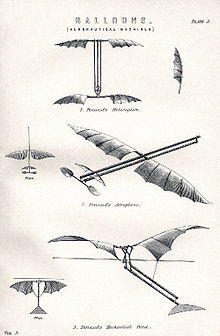Alphonse Pénaud
Alphonse Pénaud | |
|---|---|
 | |
| Born | 31 May 1850 |
| Died | 22 October 1880 (aged 30) |
| Nationality | French |
| Occupation(s) | Aeronautical inventor and engineer |
Alphonse Pénaud (31 May 1850 – 22 October 1880), was a 19th-century

1871 'Planophore
1873 ornithopter
Biography
Pénaud was born in Paris into a naval family, his father Charles Pénaud being an admiral in the French Navy. Because of a hip disease he walked with the aid of crutches and so was unable to attend the Naval School. At 20, he began studying aviation and joined the newly-founded Société Aéronautique de France. He became vice-president of the Society in 1876 and participated in the publication of the journal L'Aéronaute.
In 1870, Pénaud made the first of a series of successful model helicopters. The principle of this was not new, having been demonstrated to the French Academy of Sciences in 1784 by M. Launoy, a naturalist, and M. Bienvenu,
Planophore
The next year he built the Planophore, which was to be a major influence on early aircraft design. In addition to the use of a twisted rubber motor driving a
The Planophore was 51 cm (20 in) long with a wingspan of 46 cm (18 in) and a wing area of 0.05 m² (0.53 ft2) with a two-bladed propeller 20 cm (8 in) in diameter. It weighed 16 g (0.56 oz), of which the rubber accounted for 5 g (0.17 oz).[3]
Later work
The following year he produced a rubber-driven
He also participated in lighter than air experimentation, and produced a number of ingenious devices, including a differential barometer to show the rate of ascent or descent.
Alphonse Pénaud was unable to obtain any financial backing for his ambitious design and committed suicide on 22 October 1880, aged 30.
Influence
- Pénaud's experiments were comprehensively described by Octave Chanute in his book Progress in Flying Machines.
- A helicopter of the Pénaud type was given to the Wright Brothersby their father in 1878. The Wright brothers would later mention it as an early inspiration for their interest in flight.
- Pénaud is one of the unsuccessful aviation pioneers mentioned in the The Airborne Symphony.
Notes
- ^ "Progress in Flying Machines: Wings, March 1892".
- ^ Gibbs-Smith 2003 p.56
- ^ Octave Chanute, Progress in Flying Machines
References
- Gibb-Smith Charles H. Aviation: An Historical survey London, NMSI 2003. ISBN 1-900747-52-9
- Kane, Robert M. (2002) [1967]. "Development of the Airplane". Air Transportation (14th ed.). Kendall Hunt. p. 45. ISBN 978-0-7872-8881-5. Retrieved October 1, 2009.
- Aviation, The Pioneer Years, edited by Ben Mackworth-Praed, Studio Editions, Ltd., London, 1990
